| Frederik IX | |
|---|---|
_-_Det_Kongelige_Bibliotek_(KE062449).jpg.webp) King Frederik IX c. 1947 | |
| King of Denmark | |
| Reign | 20 April 1947 – 14 January 1972 |
| Predecessor | Christian X |
| Successor | Margrethe II |
| Prime Ministers | |
| Born | 11 March 1899 Sorgenfri Palace, Kongens Lyngby, Denmark |
| Died | 14 January 1972 (aged 72) Municipal Hospital,[1] Copenhagen, Denmark[2] |
| Burial | 24 January 1972 Roskilde Cathedral, Roskilde, Denmark |
| Spouse | |
| Issue | |
| House | Glücksburg |
| Father | Christian X of Denmark |
| Mother | Alexandrine of Mecklenburg-Schwerin |
| Religion | Church of Denmark |
Frederik IX (Danish: Christian Frederik Franz Michael Carl Valdemar Georg; 11 March 1899 – 14 January 1972) was King of Denmark from 1947 to 1972.[3] Born into the House of Glücksburg, Frederik was the elder son of King Christian X and Queen Alexandrine of Denmark. He became crown prince when his father succeeded as king in 1912. As a young man, he was educated at the Royal Danish Naval Academy. In 1935, he married Princess Ingrid of Sweden and they had three daughters, Margrethe, Benedikte and Anne-Marie. During Nazi Germany's occupation of Denmark, Frederik acted as regent on behalf of his father from 1942 until 1943.[4][5] Frederik became king on his father's death in early 1947. During Frederik IX's reign Danish society changed rapidly, the welfare state was expanded and, as a consequence of the booming economy of the 1960s, women entered the labour market. The modernization brought new demands on the monarchy and Frederik's role as a constitutional monarch. Frederik IX died in 1972, and was succeeded by his eldest daughter, Queen Margrethe II.[6]
Birth and family

Prince Frederik was born on 11 March 1899 at his parents' country residence, the Sorgenfri Palace, located on the shores of the small river Mølleåen in Kongens Lyngby north of Copenhagen on the island of Zealand in Denmark, during the reign of his great-grandfather King Christian IX. His father was Prince Christian of Denmark (later King Christian X), the eldest son of Crown Prince Frederik and Princess Louise of Sweden (later King Frederik VIII and Queen Louise). His mother was Alexandrine of Mecklenburg-Schwerin, the eldest daughter of Frederick Francis III, Grand Duke of Mecklenburg-Schwerin and Grand Duchess Anastasia Mikhailovna of Russia.
He was baptised at Sorgenfri Palace on 9 April 1899 by the Chaplain-in-Ordinary Jakob Paulli. The young prince had 21 godparents: Christian IX of Denmark (his paternal great-grandfather); Crown Prince Frederik of Denmark (his paternal grandfather); the Dowager Grand Duchess Anastasia of Mecklenburg-Schwerin (his maternal grandmother); Grand Duke Michael Nikolaevich of Russia (his maternal great-grandfather); Dowager Grand Duchess Marie of Mecklenburg-Schwerin (his maternal step-great-grandmother); Prince Carl of Denmark (his paternal uncle); Princess Thyra of Denmark (his paternal aunt); Frederick Francis IV, Grand Duke of Mecklenburg-Schwerin (his maternal uncle); George I of Greece (his paternal great-uncle); Edward, Prince of Wales (his paternal great-uncle by marriage); Ernest August, Duke of Cumberland (his paternal great-uncle by marriage); Grand Duke Alexander Mikhailovich of Russia (his maternal great-uncle); his first cousins once removed, Nicholas II of Russia, George, Duke of York, Prince George of Greece and Denmark and Georg Wilhelm, Hereditary Prince of Hanover; Crown Prince Constantine and Crown Princess Sophia of Greece (his first cousin once removed, and his wife); his paternal great-granduncles, Prince Johann of Schleswig-Holstein-Sonderburg-Glücksburg and King Oscar II of Sweden and Norway; and Crown Prince Gustaf and Crown Princess Victoria of Sweden (his first cousin twice removed and his wife).[7]
Frederik's only sibling, Knud, was born one year after Frederik. The family lived in apartments in Christian VIII's Palace at Amalienborg Palace in Copenhagen, in Sorgenfri Palace near the capital and in a summer residence, Marselisborg Palace in Aarhus in Jutland, which Frederik's parents had received as a wedding present from the people of Denmark in 1898. In 1914, the King also built the villa Klitgården in Skagen in Northern Jutland.
Early life
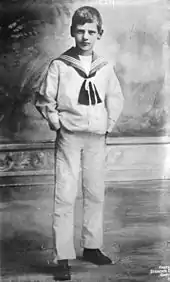
Christian IX died on 29 January 1906, and Frederik's grandfather Crown Prince Frederik succeeded him as King Frederik VIII. Frederik's father became crown prince, and Frederik moved up to second in line to the throne.
Just six years later, on 14 May 1912, King Frederik VIII died, and Frederik's father ascended the throne as King Christian X. Frederik himself became crown prince. On 1 December 1918, as the Danish–Icelandic Act of Union recognized Iceland as a fully sovereign state in personal union with Denmark through a common monarch, Frederik also became crown prince of Iceland (where his name was officially spelled Friðrik). However, as a national referendum established the Republic of Iceland on 17 June 1944, he never succeeded as king of Iceland.
Frederik was educated at the Royal Danish Naval Academy (breaking with Danish royal tradition by choosing a naval instead of an army career) and the University of Copenhagen. Before he became king, he had acquired the rank of rear admiral and he had had several senior commands on active service. He acquired several tattoos during his naval service.
In addition, with his great love of music, the king was an able piano player and conductor ([8])
Marriage and issue
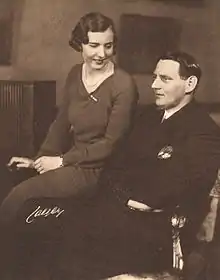
In the 1910s, Alexandrine considered the two youngest daughters of her cousin Tsar Nicholas II, Grand Duchess Maria Nikolaevna of Russia and Grand Duchess Anastasia Nikolaevna of Russia, as possible wives for Frederik, until the execution of the Romanov family in 1918. In 1922, Frederik was engaged to Princess Olga of Greece and Denmark, his second cousin. They never wed.[9][10]
Instead, on 15 March 1935, a few days after his 36th birthday, he was engaged to Princess Ingrid of Sweden (1910–2000), a daughter of Crown Prince Gustaf Adolf (later King Gustaf VI Adolf of Sweden) and his first wife, Princess Margaret of Connaught. They were related in several ways. In descent from Oscar I of Sweden and Leopold, Grand Duke of Baden, they were double third cousins. In descent from Paul I of Russia, Frederik was a fourth cousin of Ingrid's mother. They married in Stockholm Cathedral on 24 May 1935. Their wedding was one of the greatest media events of the day in Sweden in 1935, and among the wedding guests were the King and Queen of Denmark, the King and Queen of Belgium and the Crown Prince and Crown Princess of Norway.
Upon their return to Denmark, the couple were given Frederik VIII's Palace at Amalienborg Palace in Copenhagen as their primary residence and Gråsten Palace in Northern Schleswig as a summer residence.
Their daughters are:
- Queen Margrethe II of Denmark, born 16 April 1940, married to Count Henri de Laborde of Monpezat and has two sons
- Princess Benedikte of Denmark, born 29 April 1944, married to Richard, 6th Prince of Sayn-Wittgenstein-Berleburg and has three children
- Princess Anne-Marie of Denmark, born 30 August 1946, married to King Constantine II of Greece and has five children
Reign

From 1942 until 1943, Frederik acted as regent on behalf of his father who was temporarily incapacitated after a fall from his horse in October 1942.
On 20 April 1947, Christian X died, and Frederik succeeded to the throne. He was proclaimed king from the balcony of Christiansborg Palace by Prime Minister Knud Kristensen.
Frederik IX's reign saw great change. During these years, Danish society shook off the restrictions of an agricultural society, developed a welfare state, and, as a consequence of the booming economy of the 1960s, women entered the labour market. In other words, Denmark became a modern country, which meant new demands on the monarchy.
In 1948, one year into the king's reign, the Faroe Islands obtained home rule and became a self-governing country within the Danish Realm.
Changes to the Act of Succession
As King Frederik IX and Queen Ingrid had no sons, it was expected that the king's younger brother, Prince Knud, would inherit the throne, in accordance with Denmark's succession law (Royal Ordinance of 1853).
However, in 1953, an Act of Succession was passed, changing the method of succession to male-preference primogeniture (which allows daughters to succeed if there are no sons). This meant that his daughters could succeed him if he had no sons. As a consequence, his eldest daughter, Margrethe, became heir presumptive. By order of 27 March 1953 the succession to the throne was limited to the issue of King Christian X.
Death and funeral

Shortly after the King had delivered his New Year's Address to the Nation at the 1971/72 turn of the year, he became ill with flu-like symptoms. After a few days rest, he suffered cardiac arrest and was rushed to the Copenhagen Municipal Hospital on 3 January. After a brief period of apparent improvement, the King's condition took a negative turn on 11 January, and he died 3 days later, on 14 January, at 7:50 pm surrounded by his immediate family and closest friends, having been unconscious since the previous day.[11][12]
Following his death, the King's coffin was transported to his home at Amalienborg Palace, where it stood until 18 January, when it was moved to the chapel at Christiansborg Palace.[13] There the King was placed on castrum doloris, a ceremony largely unchanged since introduced at the burial of Frederik III in 1670, and the last remaining royal ceremony where the Danish Crown Regalia is used. The King then lay in state for six days until his funeral, during which period the public could pay their last respects.[14]
The funeral took place on 24 January 1972, and was split in two parts. First a brief ceremony was held in the chapel where the king had lain in state, where the Bishop of Copenhagen, Willy Westergaard Madsen, said a brief prayer, followed by a hymn, before the coffin was carried out of the chapel by members of the Royal Life Guards and placed on a gun carriage for the journey through Copenhagen to Copenhagen Central Station. The gun carriage was pulled by 48 seamen and was escorted by honor guards from the Danish Army, Air Force, and Navy, as well as honor guards from France, Sweden, United Kingdom, and the United States.[15]
At the Copenhagen Central Station, the coffin was placed in a special railway carriage for the rail journey to Roskilde. The funeral train was pulled by two DSB class E steam engines. Once in Roskilde, the coffin was pulled through the city by a group of seamen to Roskilde Cathedral where the final ceremony took place. Previous rulers had been interred in the cathedral, but it was the King's wish to be buried outside.[16]
Succession
He was succeeded by his eldest daughter, Queen Margrethe II.[17] Queen Ingrid survived her husband by 28 years. She died on 7 November 2000. Her remains were interred alongside him at the burial site outside Roskilde Cathedral.
Legacy
On 20 April 1982, a statue of King Frederik IX dressed in the uniform of an admiral was unveiled by the Copenhagen harbour on the 35th anniversary of his accession to the throne in 1947 and in the tenth year after his death.[18]
The Crown Prince Frederik Range in Greenland was named after him when it was first mapped by Sir Martin Lindsay in 1934 during the British Trans-Greenland Expedition.[19]
Titles, styles and honours

Titles and styles
- 9 April 1899 – 14 May 1912: His Royal Highness Prince Frederik of Denmark
- 14 May 1912 – 1 December 1918: His Royal Highness The Crown Prince of Denmark
- 1 December 1918 – 17 June 1944: His Royal Highness The Crown Prince of Denmark and Iceland[20]
- 17 June 1944 – 20 April 1947: His Royal Highness The Crown Prince of Denmark
- 20 April 1947 – 14 January 1972: His Majesty The King of Denmark
Honours
- Danish honours[21]
- Knight of the Elephant, 14 May 1912
- Cross of Honour of the Order of the Dannebrog, 11 March 1917
- Grand Commander of the Dannebrog, 3 February 1936
- King Christian IX Centenary Medal
- King Frederik VIII Centenary Medal
- Navy Long Service Award
- Foreign honours[22]
 Iceland: Grand Cross of the Falcon[23]
Iceland: Grand Cross of the Falcon[23]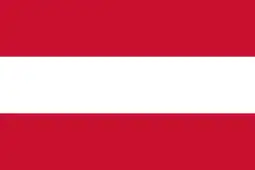 Austria: Grand Star of the Decoration for Services to the Republic of Austria[24]
Austria: Grand Star of the Decoration for Services to the Republic of Austria[24].svg.png.webp) Belgium: Grand Cordon of the Order of Leopold
Belgium: Grand Cordon of the Order of Leopold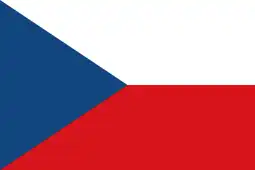 Czechoslovakia: Collar of the White Lion, 22 May 1935
Czechoslovakia: Collar of the White Lion, 22 May 1935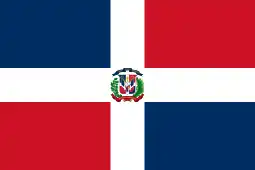 Dominican Republic: Grand Cross of the Order of Merit, with Gold Star
Dominican Republic: Grand Cross of the Order of Merit, with Gold Star.svg.png.webp) Ethiopian Imperial Family: Grand Cross of the Seal of Solomon
Ethiopian Imperial Family: Grand Cross of the Seal of Solomon Finland:
Finland:
- Collar of the White Rose, 1926[25]
- Commemoration Medal for the Finnish War of Liberation of 1918
- Gold Commemoration Medal for the Winter War of 1939/40
- Medal for Humane Benevolence
.svg.png.webp) German Imperial and Royal Family:
German Imperial and Royal Family:
.svg.png.webp) Greek Royal Family:
Greek Royal Family:
- Grand Cross of the Redeemer
- Grand Cross of the Order of George I
- Grand Cross of Saints George and Constantine
- Commemorative Badge of the Centenary of the Royal House of Greece
 France: Grand Cross of the Legion of Honour
France: Grand Cross of the Legion of Honour.svg.png.webp) Iranian Imperial Family:
Iranian Imperial Family:
- Collar of the Order of Pahlavi
_crowned.svg.png.webp) Italian Royal Family: Knight of the Annunciation, 10 March 1917[26]
Italian Royal Family: Knight of the Annunciation, 10 March 1917[26].svg.png.webp) Empire of Japan: Collar of the Order of the Chrysanthemum
Empire of Japan: Collar of the Order of the Chrysanthemum Netherlands: Grand Cross of the Netherlands Lion
Netherlands: Grand Cross of the Netherlands Lion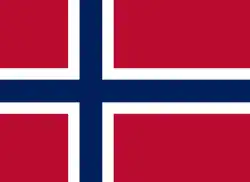 Norway: Grand Cross of St. Olav, with Collar, 10 April 1917[27]
Norway: Grand Cross of St. Olav, with Collar, 10 April 1917[27]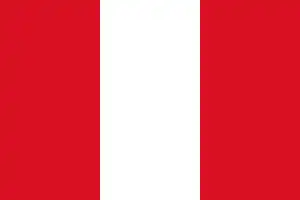 Peru: Grand Cross of the Sun of Peru, in Diamonds
Peru: Grand Cross of the Sun of Peru, in Diamonds Russian Imperial Family:
Russian Imperial Family:
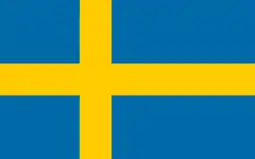 Sweden:
Sweden:
- Knight of the Seraphim, with Collar, 11 March 1917[28][29]
- King Gustaf V Commemorative Medal
 Thailand:
Thailand:
- Knight of the Order of the Royal House of Chakri, 18 February 1917[30]
- Grand Cordon of the Order of Chula Chom Klao
 United Kingdom:
United Kingdom:
- Stranger Knight Companion of the Garter, 8 May 1951
- Honorary Grand Cross of the Bath
- Honorary Grand Cross of the Royal Victorian Order
- Associate Bailiff Grand Cross of St. John[31]
- Recipient of the King George VI Coronation Medal
- Honorary military appointments
- 1947–61: Colonel-in-Chief of the Buffs (Royal East Kent Regiment)[32]
- 1961–66: Colonel-in-Chief of the Queen's Own Buffs, The Royal Kent Regiment
- 1966–72: Colonel-in-Chief of the Queen's Regiment[33][34]
Ancestors
| Ancestors of Frederik IX of Denmark |
|---|
References
Citations
- ↑ "Margarita de Dinamarca cuenta el drama de ver enfermar y morir a su padre en 14 días". Archived from the original on 2 November 2021. Retrieved 26 August 2019.
- ↑ "Frederik of Denmark Dies; Margrethe to Be Queen". The New York Times. New York, N. Y. 15 January 1972. p. 1.
- ↑ "Frederik 9". kongernessamling.dk. Archived from the original on 7 August 2019. Retrieved 1 December 2019.
- ↑ "Queen Anne-Marie". The Greek Royal Family. Archived from the original on 26 December 2019. Retrieved 1 December 2019.
- ↑ "H.K.H. Prinsesse Benedikte". kongehuset.dk. 28 November 2015. Archived from the original on 30 July 2019. Retrieved 1 December 2019.
- ↑ "The Royal Lineage". kongehuset.dk. 7 April 2016. Archived from the original on 8 August 2019. Retrieved 1 December 2019.
- ↑ "Prinser og Prinsesser kommer også i kirkebogen". The Danish State Archives. Retrieved 10 August 2011.
- ↑ "Frederik IX". 15 March 2016. Archived from the original on 3 June 2023. Retrieved 3 June 2023.
- ↑ "DANISH HEIR ENGAGED.; Crown Prince Will Wed Princess Olga of Greece". The New York Times. Associated Press. 6 March 1922. Retrieved 13 May 2017.
- ↑ "CONSTANTINE'S NIECE NOT TO WED PRINCE; Engagement of Princess Olga and Heir to the Danish Throne Is Annuled (sic)". The New York Times. Associated Press. 28 September 1922. Retrieved 13 May 2017.
- ↑ Jon Bloch Skipper. Sømandskongen. Pp 300—309. Aschehoug (2005). ISBN 978-87-1111-789-7.
- ↑ "Frederik of Denmark Dies. Margrethe to Be Queen". New York Times. 15 January 1972. Archived from the original on 28 March 2023. Retrieved 8 February 2017.
- ↑ "Royalty and Danish Commoners Honor King Frederik at Burial". New York Times. Associated Press. 25 January 1972. Archived from the original on 7 March 2018. Retrieved 8 February 2017.
- ↑ Jon Bloch Skipper. Sømandskongen. Pp 315. Aschehoug (2005). ISBN 978-87-1111-789-7.
- ↑ "Hans Majestæt, Kong Frederik den IX's bisættelse 1:2". DR. 24 January 1972. Archived from the original on 15 January 2023. Retrieved 14 January 2023.
- ↑ Roger Lundgren. Ingrid. Pp 147. People'sPress (2010). ISBN 978-87-7055-826-6.
- ↑ "Margrethe Proclaimed Queen of Denmark in Brief Ceremony at Palace". New York Times. Reuters. 16 January 1972. Archived from the original on 28 March 2023. Retrieved 8 February 2017.
- ↑ "King Frederick IX (1899-1972)". The City of Copenhagen. Archived from the original on 17 September 2007. Retrieved 10 August 2011.
- ↑ "French Honour For British Explorer", The Times, 12 April 1935.
- ↑ e.g. Franklin D. Roosevelt (1 May 1939). Gerhard Peters; John T. Woolley (eds.). "Address at the Dedication of the New Post Office in Rhinebeck, New York". The American Presidency Project. Archived from the original on 18 August 2016. Retrieved 2 July 2016.
- ↑ Bille-Hansen, A. C.; Holck, Harald, eds. (1943) [1st pub.:1801]. Statshaandbog for Kongeriget Danmark for Aaret 1943 [State Manual of the Kingdom of Denmark for the Year 1943] (PDF). Kongelig Dansk Hof- og Statskalender (in Danish). Copenhagen: J.H. Schultz A.-S. Universitetsbogtrykkeri. pp. 17–18. Archived (PDF) from the original on 23 September 2019. Retrieved 16 September 2019 – via da:DIS Danmark.
- ↑ Bille-Hansen, A. C.; Holck, Harald, eds. (1963) [1st pub.:1801]. Statshaandbog for Kongeriget Danmark for Aaret 1963 [State Manual of the Kingdom of Denmark for the Year 1963] (PDF). Kongelig Dansk Hof- og Statskalender (in Danish). Copenhagen: J.H. Schultz A.-S. Universitetsbogtrykkeri. p. 17. Archived (PDF) from the original on 22 September 2019. Retrieved 16 September 2019 – via da:DIS Danmark.
- ↑ "bryllupsbillede". kongehuset.dk. Archived from the original on 3 June 2014. Retrieved 15 September 2015.
- ↑ "Reply to a parliamentary question" (PDF). Parlament.gv.at (in German). p. 134. Archived (PDF) from the original on 1 May 2020. Retrieved 8 October 2012.
- ↑ "Suomen Valkoisen Ruusun Suurristi Ketjuineen". ritarikunnat.fi (in Finnish). Archived from the original on 27 September 2020. Retrieved 7 May 2020.
- ↑ Italy. Ministero dell'interno (1920). Calendario generale del regno d'Italia. p. 58. Archived from the original on 22 September 2023. Retrieved 8 October 2020.
- ↑ "Den kongelige norske Sanct Olavs Orden", Norges Statskalender (in Norwegian), 1922, pp. 1173–1174, archived from the original on 17 September 2021, retrieved 17 September 2021 – via hathitrust.org
- ↑ Sveriges Statskalender (in Swedish), vol. 2, 1940, p. 7, archived from the original on 7 January 2018, retrieved 6 January 2018 – via runeberg.org
- ↑ "Image: 505953022_2_Big.jpg, (449 × 600 px)". 3.bp.blogspot.com. Archived from the original on 4 March 2015. Retrieved 15 September 2015.
- ↑ พระราชทานเครื่องราชอิสริยาภรณ์ (PDF). Royal Thai Government Gazette (in Thai). 3 March 1917. Archived from the original (PDF) on 4 March 2016. Retrieved 8 May 2019.
- ↑ "No. 38339". The London Gazette. 29 June 1948. p. 3787.
- ↑ "The Buffs (East Kent Regiment)" (PDF). Kent Fallen. Archived (PDF) from the original on 3 September 2012. Retrieved 30 December 2015.
- ↑ "The Queen's Regiment". Regiments.org. Archived from the original on 10 February 2006. Retrieved 20 July 2016.
- ↑ "Connection with The Princess of Wales Royal Regiment". The Danish Royal House. 22 April 2023. Archived from the original on 1 July 2023. Retrieved 30 June 2023.
Bibliography
- Bramsen, Bo (1992). Huset Glücksborg. Europas svigerfader og hans efterslægt [The House of Glücksburg. The Father-in-law of Europe and his descendants] (in Danish) (2nd ed.). Copenhagen: Forlaget Forum. ISBN 87-553-1843-6.
- Fabricius Møller, Jes (2013). Dynastiet Glücksborg, en Danmarkshistorie [The Glücksborg Dynasty, a history of Denmark] (in Danish). Copenhagen: Gad. ISBN 978-87-12-04841-1.
- Lerche, Anna; Mandal, Marcus (2003). A royal family: the story of Christian IX and his European descendants. Copenhagen: Aschehoug. ISBN 978-87-15-10957-7.
- Scocozza, Benito (1997). "Frederik 9.". Politikens bog om danske monarker [Politiken's book about Danish monarchs] (in Danish). Copenhagen: Politikens Forlag. pp. 200–203. ISBN 87-567-5772-7.
External links
- The Royal Lineage at the website of the Danish Monarchy
- Frederik IX at the website of the Royal Danish Collection at Amalienborg Palace
- Newspaper clippings about Frederik IX of Denmark in the 20th Century Press Archives of the ZBW
.svg.png.webp)
